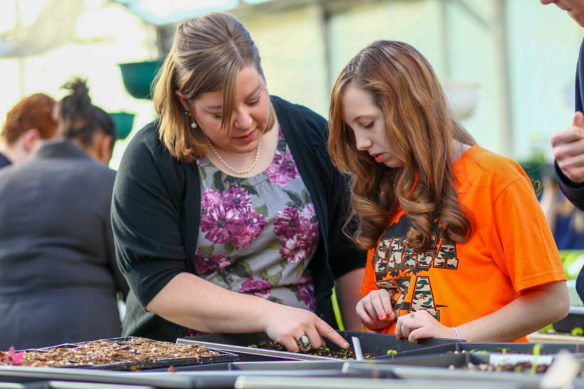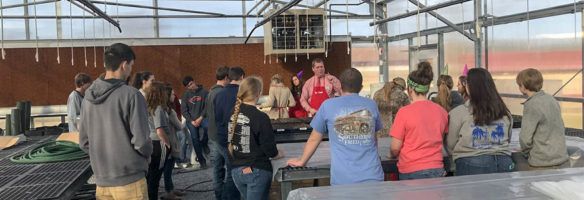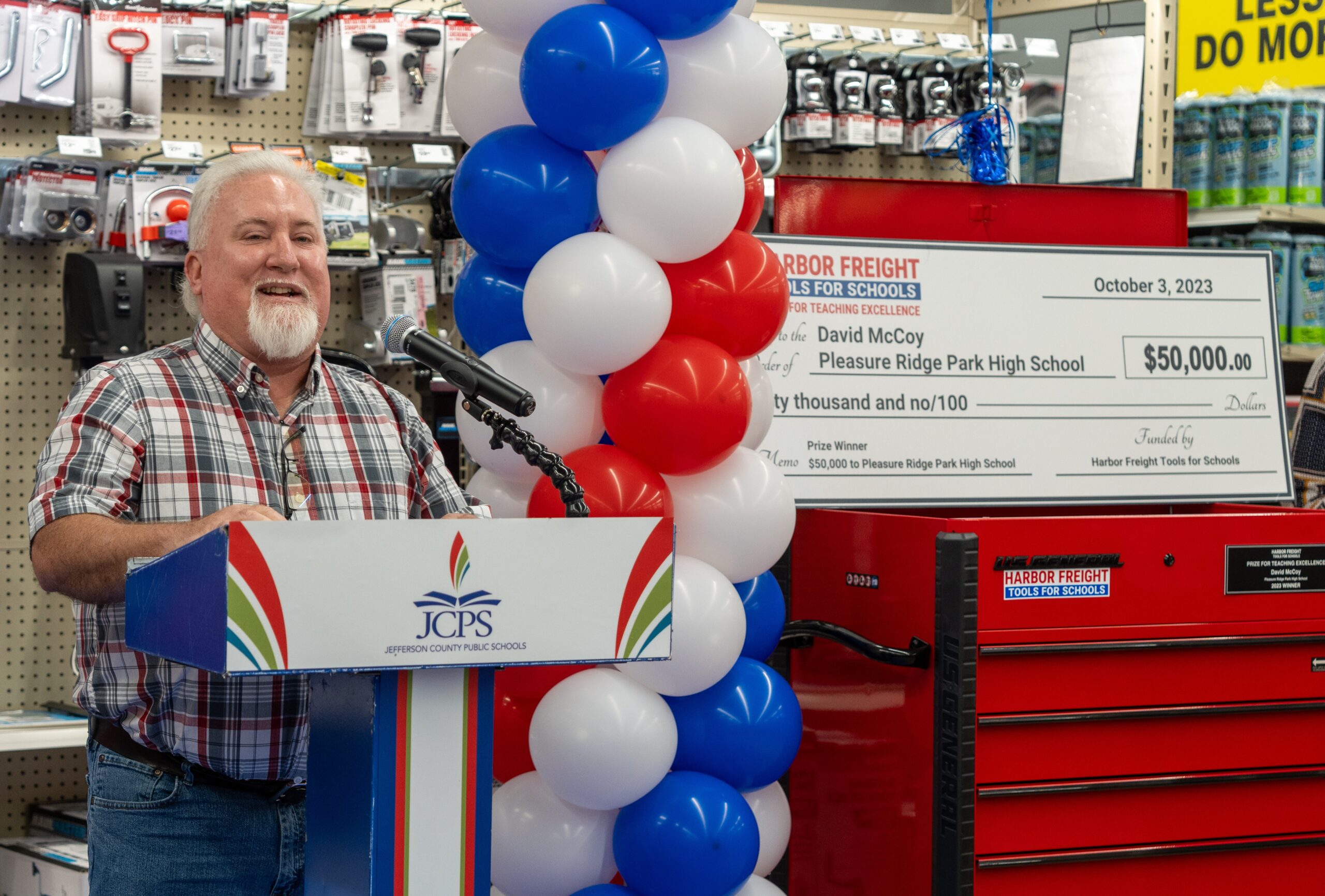
Seneca High School agriculture teacher Bethany Mattingly instructs a student on how to transplant tomatoes in the school’s greenhouse. Beginning in the 1980s, greenhouses became a common teaching tool in agricultural education programs across the state. Today, more than 100 of the state’s 144 high school agricultural education programs have a greenhouse of some kind.
Submitted photo by National FFA Alumni
“When am I ever going to use this in real life?” is a question that Jacob Falwell seldom has to answer in his agricultural education classroom at Calloway County High School. If he ever is asked the question, he simply points students toward the school greenhouse.
Four years of instruction about plant anatomy, soil, nutrition, disease, pests, business management and marketing come to life as students produce plants for sale to the public.
“The greenhouse takes all of the classroom instruction and puts it into practice,” Falwell said.
Halfway across the state at Seneca High School (Jefferson County), Bethany Mattingly’s students also are hard at work preparing for spring plant sales. For many of her students, the greenhouse is their first chance to plant something and watch it grow. In addition to plant production, Seneca students also are practicing valuable skills related to business management and marketing.
“Students make the decisions on what is going to be sold, pricing, marketing techniques, and have roles as sales associates while the business operates,” Mattingly said.
Beginning in the 1980s, greenhouses became a common teaching tool in agricultural education programs across the state. Today, more than 100 of the state’s 144 high school agricultural education programs have a greenhouse of some kind.
“Greenhouses provide a great opportunity for hands-on learning in the Horticulture and Plant Science Pathway,” said Brandon K. Davis, a Kentucky Department of Education agricultural education consultant. “They allow students to learn concepts in the classroom and then walk outside and put that learning into practice.”
The first issue in running a greenhouse is determining what to grow. At Seneca, Mattingly’s students use product demand from past years and research about new varieties to help with this process. Demand varies greatly from community to community, with rural customers preferring vegetable plants and urban customers seeking hanging baskets and pre-made planters.
The growing process begins in earnest during the cold winter months. Both Seneca and Calloway County grow some plants from seeds and others from plugs (small plants that are germinated by another greenhouse). Falwell said that while seeds are cheaper, plugs are sometimes a better option.
“Some seeds like geraniums are hard to germinate,” he said, “so we pay the extra money to get them started by a commercial grower.”

Calloway County High School agriculture teacher Jacob Falwell demonstrates proper methods for seeding plants earlier this spring. After a devastating fire destroyed the greenhouse two years ago, Calloway County tapped a variety of grants and other community programs to relaunch their greenhouse this year.
Submitted photo by Tawnya Hunter, Calloway County Schools
Start-up costs for a new greenhouse program for soil, pots, seeds and other items can be expensive. After the first year, these are normally paid for from earnings retained from the previous year. After a devastating fire destroyed the greenhouse two years ago, Calloway County tapped a variety of grants and other community programs to relaunch their greenhouse this year.
Running a greenhouse is not without problems, however those problems can become a valuable part of the learning process.
“A few years ago we had a big problem in our greenhouse with fungus gnats,” Mattingly said. “The students created an integrated pest management plan and treated the pests using cultural and mechanical techniques. The content learning surged because of the pest problem that students had to solve. Students had to use life skills to think about multiple approaches to solve the problem.”
While the hands-on learning provided by the greenhouse is a great opportunity for students, it presents challenges for teachers in terms of management and student engagement that are not part of the normal classroom environment. Mattingly tries to increase student engagement by spending the first part of each class developing a list of five to eight objectives that must be accomplished. She then puts students into groups and assigns one of the objectives to each group.
“Sometimes I select a group leader, sometimes I ask for volunteers and sometimes I let the groups select their leader,” she said.
Under this system, group leaders learn to work with their team members, leaders have to take responsibility for what is accomplished by their group and Mattingly is free to provide support where she is needed most.
Falwell said clear expectations also are important.
“I try to have assignments for each student at the beginning of class, the more specific the better,” he said.
He also has found value in reviewing what was accomplished at the end of the class period.
“We try to talk about what we did, but also why we did it,” Falwell said. “This helps the student’s gain a sense of accomplishment and helps me evaluate how productive we were during the day.”
Plant sales begin in mid-April and run through May in most communities. The sales process is a great final exam for the course according to Mattingly.
“Customers will ask questions like ‘How big will this get?’ ‘Where should I plant this?’ and ‘How much water does it need?’ and they have to be ready to answer them,” she said. “Most greenhouses are open during part of the school day, after school and on a few Saturdays. Proceeds from the greenhouse are used to pay for supplies and enhance instruction in the agricultural education program.”
Falwell and Mattingly both work to ensure that their greenhouses contribute to the community. Seneca donates plants to churches, community groups and retirement centers in the Louisville area. Extra vegetable plants go to organizations that fight hunger and help provide fresh, nutritious food throughout the summer. Calloway County helps celebrate Earth Day by planting flowers they’ve grown in the community and works with local elementary schools, factories and community events to promote a better understanding of agriculture.
Both teachers are quick to note that managing a greenhouse is not an easy task. In addition to the day-to-day work involved in managing student work, they spend countless hours ordering supplies, managing the greenhouse environment and selling plants after school and on weekends.
But, Mattingly said, “All the work is worth it when you see the pride of a student carrying a plant they have grown to the car of a happy customer.”
Matt Chaliff is an agricultural education consultant at the Kentucky Department of Education. He began his career as a teacher of agriculture at Taylor County High School.



Leave A Comment